| ||||||||||||||||
| Turnout | 964 | |||||||||||||||
|---|---|---|---|---|---|---|---|---|---|---|---|---|---|---|---|---|
| ||||||||||||||||
| ||||||||||||||||
The 1889 Oamaru by-election was a by-election held on 30 September 1889 in the Oamaru electorate during the 10th New Zealand Parliament.
| ||||||||||||||||
| Turnout | 964 | |||||||||||||||
|---|---|---|---|---|---|---|---|---|---|---|---|---|---|---|---|---|
| ||||||||||||||||
| ||||||||||||||||
The 1889 Oamaru by-election was a by-election held on 30 September 1889 in the Oamaru electorate during the 10th New Zealand Parliament.
The by-election was triggered by the resignation of the incumbent MP Thomas William Hislop. The resignation was caused by the Ward-Hislop affair where Hislop was reproached by a Legislative Council committee for his manner of correspondence with a District Judge Ward. The report judged that he was using his Ministerial position to aid the business affairs of his personal friends. [1] He had also resigned his ministerial portfolios. [2]
Hislop stood again to regain his position as an MP. He was opposed by David Dunn. [3] Dunn, the Liberal Party candidate, claimed to be "...one having no political experience at all." [4] This was despite the fact that he had been elected Mayor of Oamaru in 1888. [5]
Hislop's majority was reduced from 136 to 134 after two votes were removed. [6] One person was charged with voting twice (personation). [7]
The following table gives the election result:
| Party | Candidate | Votes | % | ±% | |
|---|---|---|---|---|---|
| Independent | Thomas William Hislop | 549 | 56.95 | ||
| Liberal | David Dunn | 415 | 43.05 | ||
| Majority | 134 | 13.90 | |||
| Turnout | 964 | ||||

Christopher Joseph Carter is a former New Zealand Labour Party and independent Member of the New Zealand Parliament. He was a senior Cabinet Minister in the Fifth Labour Government of New Zealand, serving lastly as Minister of Education, Minister Responsible for the Education Review Office and Minister of Ethnic Affairs. He was the Member of Parliament for the Te Atatu electorate, where he was first elected in 1993. He did not win re-election in 1996, but won a new and expanded Te Atatu seat in 1999. In 2010, he was suspended from the Labour Party caucus following a dispute with party leader Phil Goff, shortly afterwards he became an independent MP. He was expelled by the Labour Party for breaching the Party's constitution in bringing the Party in disrepute, on 11 October 2010. In September 2011 Carter resigned from Parliament following his appointment to a United Nations position in Afghanistan where he served for 4 years. In 2015 he was appointed to head UN operations in Rakhine State in Myanmar where he served for 3 years. In 2018 he rejoined the New Zealand Labour Party and stood for election as a Labour Party representative in the 2019 New Zealand local elections. Carter was elected and appointed as Chairperson of the Henderson Massey Local Board with 11,250 votes. He also won election in 2019 as one of the seven elected board members of the Waitemata District Health Board with 14,593 votes. Both positions have three year terms.

Christine Elizabeth Fletcher is a New Zealand politician. Currently an Auckland Council councillor, she was previously a National Party Member of Parliament from 1990 to 1999, and served one term as Mayor of Auckland City between 1998 and 2001. In October 2010 she became the co-leader of the Auckland local body ticket Citizens & Ratepayers after winning the Albert-Eden-Roskill ward on the new Auckland Council.

Maurice Donald Williamson is a New Zealand politician and former diplomat.

Aupito Tofae Su'a William Sio is a politician who became a member of the New Zealand House of Representatives on 1 April 2008 for the Labour Party as a list MP. From the November 2008 election to 2023, he represented the Māngere electorate.
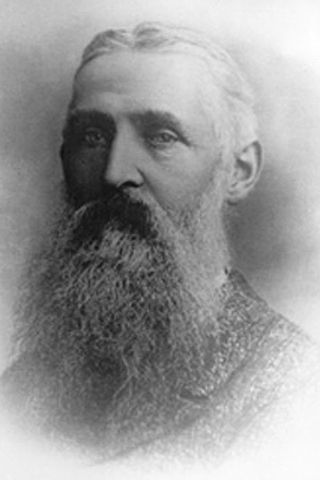
Sir William Jukes Steward was a New Zealand politician and the first Liberal Speaker of the New Zealand House of Representatives. He represented South Canterbury electorates in Parliament for a total of 34 years, before being appointed to the Legislative Council. He served briefly on the Otago Provincial Council and was Mayor of Oamaru for three years.

Dunedin North is a former New Zealand parliamentary electorate, which returned one Member of Parliament (MP) to the New Zealand House of Representatives. It was established for the 1905 election and has existed since. It was last held by David Clark of the New Zealand Labour Party, who replaced the long-standing representative Pete Hodgson. It was considered a safe Labour seat, with Labour holding the seat for all but one term (1975–1978) since 1928. In the 2020 electoral boundary review, Otago Peninsula was added to the area to address a population quota shortfall; with this change the electorate was succeeded by the Dunedin electorate in the 2020 election.

Napier is a New Zealand parliamentary electorate, returning one Member of Parliament to the House of Representatives. It is named after the city of Napier, the main urban area within the electorate. The electorate was established for the 1861 election and has existed since. It has been held by Katie Nimon of the New Zealand National Party since the 2023 general election. It was held by Stuart Nash of the New Zealand Labour Party from the 2014 general election until 2023, when he did not stand for re-election.

Whanganui is a New Zealand parliamentary electorate. It was first established in 1860 for the 3rd Parliament and has existed continuously since then.
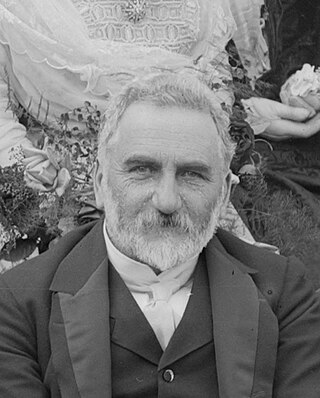
Thomas William Hislop was the Mayor of Wellington from 1905 to 1908, and had represented two South Island electorates in the New Zealand Parliament.

Waitaki is an electorate for the New Zealand House of Representatives that crosses the boundary of North Otago and South Canterbury towns on the East Coast of the South Island. The electorate was first established for the 1871 election that determined the 5th New Zealand Parliament. It has been abolished and re-established several times and in its early years was a two-member electorate for two parliamentary terms. The current electorate has existed since the 2008 election and is held by Miles Anderson of the National Party.
Christchurch North is a former New Zealand parliamentary electorate. The electorate comprised the northern half of what is now considered the Christchurch Central City.
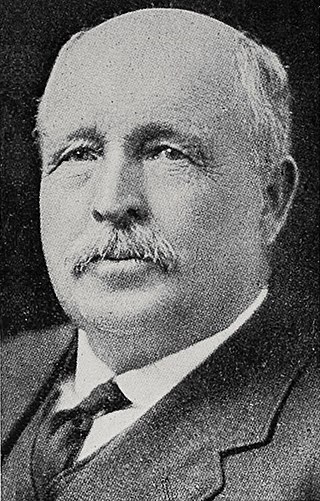
John Edie was a Liberal Party Member of Parliament in the Otago region of New Zealand. He was a surveyor and an engineer, and also spent time as a farmer. He was Mayor of Lawrence.

William Ross Laney was a New Zealand Member of Parliament representing the Labour Party, and Mayor of Oamaru.
Oamaru was a parliamentary electorate in the Otago region of New Zealand, during three periods between 1866 and 1978.
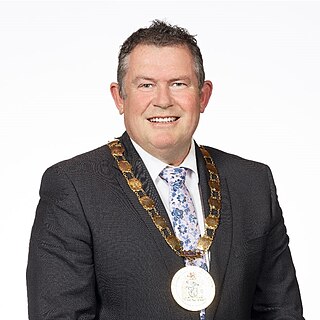
The mayor of Palmerston North is the head of the municipal government of Palmerston North, New Zealand, and presides over the Palmerston North City Council. The current mayor is Grant Smith, who became mayor in a February 2015 by-election. This resulted from the resignation of Jono Naylor in October 2014 after his election to the House of Representatives. Since the 2013 election, Palmerston North is one of the few councils that uses the single transferable vote electoral system for the election of mayor.
The Oamaru by-election 1885 was a by-election held in the Oamaru electorate during the 9th New Zealand Parliament, on 20 May 1885. The by-election was caused by the resignation of the incumbent, Samuel Shrimski, who was appointed to the Legislative Council, and was won by Thomas William Hislop.
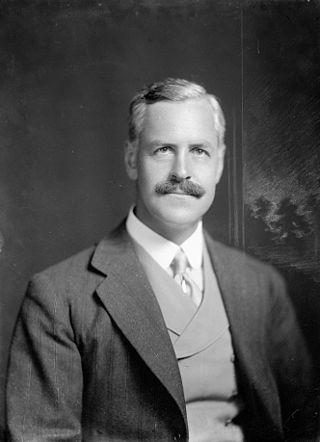
The 1917 Bay of Islands by-election was a by-election held on 19 March 1917 during the 19th New Zealand Parliament in the Northland electorate of Bay of Islands. The by-election came about because Vernon Reed's win in the 1914 general election had been declared void by an electoral court, and Reed barred from standing for a year. The seat was won by William Stewart, Reed's Reform Party colleague, in the resulting 1915 by-election. When Reed became eligible again, Stewart resigned and Reed won the 1917 by-election unopposed.
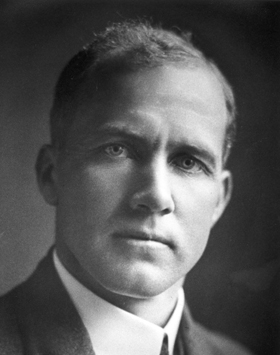
Arthur Montague "Joe" Ongley was a New Zealand lawyer, politician, and cricket and rugby union player and administrator. Born in Oamaru, he later lived in Wellington, Napier, and Hokitika, before settling in Feilding. He excelled in a number of sports and Ongley Park in Palmerston North, used for cricket and rugby, is named for him. His most notable sporting activity was as a cricketer, and he played four first-class matches. He served as an administrator on the New Zealand Cricket Council and was the organisation's president. He was a solicitor and then barrister in Feilding, and became Crown Solicitor in Palmerston North. He was a member of the Feilding Borough council and was the town's mayor from 1913 to 1919.
The 1880 Waitaki by-election was a by-election held on 16 June 1880 in the Waitaki electorate in the Otago and Canterbury regions during the 7th New Zealand Parliament.